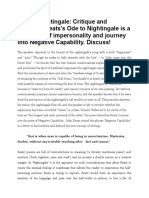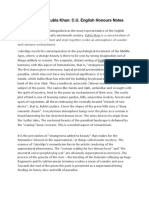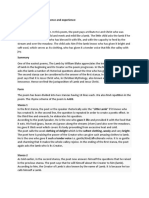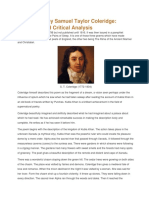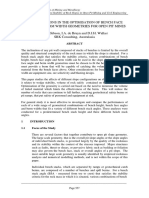ENGL 384 Assignment On To A Skylark
ENGL 384 Assignment On To A Skylark
Uploaded by
Kekeli TsikataCopyright:
Available Formats
ENGL 384 Assignment On To A Skylark
ENGL 384 Assignment On To A Skylark
Uploaded by
Kekeli TsikataOriginal Title
Copyright
Available Formats
Share this document
Did you find this document useful?
Is this content inappropriate?
Copyright:
Available Formats
ENGL 384 Assignment On To A Skylark
ENGL 384 Assignment On To A Skylark
Uploaded by
Kekeli TsikataCopyright:
Available Formats
Name: Keli Tsikata ID: 10319496 ENGL 384 The Romantic Movement in English Literature
18th April 2012
A close reading of Percy Bysshe Shelleys To a Skylark
Percy Bysshe Shelleys To a Skylark was finished in late June 1820 at which time the poet was twenty-seven years-old. The poem is an ode extolling the splendour of the song and spirit of the eponymous bird to which the poem is dedicated. Per his wife Mary Shelleys account, the inspiration for the poem came from a walk in the countryside in Livorno, Italy where Mary and Percy Shelley had chosen to go so he could recover his health. Like much of the work characteristic of the Romantic poets, To a Skylark celebrates nature, its beauty and otherworldliness in this instance using the vehicle of a songbird, the skylark. The poem suggests through the use of vivid and exquisite imagery that the bird is more than its physical form. The speaker employed in the poem suggests that the birds song encapsulates a much larger spirit, which sustains it and gives it voice lending it a mystique unavailable to the human form which in contrast is prone to burdens imposed on it by weighty thoughts and fears, profound sadness and an overwhelming awareness of mortal limits.
The speaker begins by addressing the skylark in a manner which is unabashedly reverent, even as he simultaneously downplays the reality of its physical presence
saying Hail to thee blithe spirit/bird thou never wert. He suggests with these two lines that the Skylark is the embodiment of a spiritual presence which cannot be dismissed merely as a bird. In so doing he introduces the paradox which is embedded throughout the poem between this being at once a creature of flesh and blood and it being a spiritual being. The interplay of these two seeming irreconcilable concepts is embedded in much of the poem and is a major source of tension within it. This in turn lends the skylark a larger than life place in the world which it inhabits in this piece. It emerges [f]rom the earth...like a cloud of fire, creating a bridge between the mythical allusion to the phoenix and his notion of this birds spirit and the notion of it being insubstantial and ever rising as do clouds in the natural world. The manner in which it float[s] and run[s] like an unbodied joy is a metaphor that presumes that the birds song emanates from a place of pure happiness. The skylark is constantly interacting with the world around it which only serves to enrich its song, while its presence in the world seems to feed into the surroundings. He shows this by his description of how pale purple even/melts around [its] flight. The idea of its ability to melt further emphasizes its harmony with the environment around it while simultaneously re-emphasizing its vitality and unfettered nature. He extends his envy of its state both in reality its ability to fly - and the value he confers on it - its elevated position as a spiritual being to suggest a little unrealistically, that it enjoys a privileged place removed from the troubles of a worldly existence.
His comparison of the bird to a poet coupled with the feelings of joy which inspire song versus the more human attitudes of languor and the shadow of annoyance all serve
to heighten the clear differences the poet seeks to draw between the plight of the human poet and the unencumbered happiness of the skylark. Shelleys speaker appears to envy the skylarks proximity to heaven especially because of its musical gift, its closeness to an unnamed source and its infinite ability to move a much larger audience than the poet is able by virtue of its freedom and mobility but also as its song is untainted by negative emotion. He also tries to show how insufficient the songs and words of poets and musicians are by claiming to ...have never heard/Praise of love or wine/that panted forth a flood of rapture so divine. The skylarks song is takes on a celestial quality in the mind of the speaker. We seek before and after/and pine for what is not:/Our sincerest laughter/with some pain is fraught/our sweetest songs are those that tell of saddest thought. seeks to highlight the altogether unhappy state of mortal men beside the inextinguishable spirit of the skylark.
Vivid descriptions of natural scenery such as the golden lightning/of the sunken sun/oer which clouds are brightening, the pale purple even[ing], a star of heaven/in the broad daylight, and various other images push us towards an awareness of the eternal majesty of the both the bird itself as well as of the natural world around it at varying stages - of day, of night with echoes of the present and the future implied by these changes in time - absent the interference of man. In lines 91 105, he suggests that humans have a lot to learn from this creature both for its capacity for joy in song as well as for the fact that human beings somehow seem cut off from the ability to find even half the happiness with which the skylarks song is imbued. In essence, the skylark
becomes the ultimate metaphor for divine perfection as diametrically opposed to human frailty and failure.
List of Sources 1. Quiller-Couch, Arthur Thomas, Sir. The Oxford Book of English Verse. Oxford: Clarendon, 1919, [c1901]; Bartleby.com, 1999. <www.bartleby.com/101/>. Web. 16th April 2012. 2. Wikipedia Online Encyclopedia. Wikimedia Foundation. http://en.wikipedia.org/wiki/To_a_Skylark . Web. 16 April 2012.
You might also like
- Epistolary in Pamela@ SHDocument3 pagesEpistolary in Pamela@ SHShahnawaz Hussain100% (1)
- PreludeDocument8 pagesPreludeKristi CooperNo ratings yet
- Duchess of Malfi - Moral VisionDocument14 pagesDuchess of Malfi - Moral VisionArghya Chakraborty100% (1)
- Attempt A Comparison Between The Epithalamion and The Prothalamion As Wedding Songs. - My Exam Solution PDFDocument1 pageAttempt A Comparison Between The Epithalamion and The Prothalamion As Wedding Songs. - My Exam Solution PDFBir SinghNo ratings yet
- 965-0222 Onan 3.0-4.0KW BFA (Spec A-D) RV Genset Parts Manual (03-1986) PDFDocument33 pages965-0222 Onan 3.0-4.0KW BFA (Spec A-D) RV Genset Parts Manual (03-1986) PDFBruce EgglestonNo ratings yet
- Cables Passing Through or Over Joists: BS 7671: 2008 Requires A Cable Installed Under A Floor or Above ADocument2 pagesCables Passing Through or Over Joists: BS 7671: 2008 Requires A Cable Installed Under A Floor or Above AMyoZawNo ratings yet
- To A SkylarkDocument2 pagesTo A SkylarkP S Prasanth Neyyattinkara100% (1)
- Critical AppreciationDocument13 pagesCritical Appreciationawaiskhanji545No ratings yet
- Ode To Nightingale by KeatsDocument4 pagesOde To Nightingale by Keatsmanazar hussainNo ratings yet
- tmp9634 TMPDocument24 pagestmp9634 TMPFrontiersNo ratings yet
- Growth of Poetic DramaDocument4 pagesGrowth of Poetic DramaDushyant NimavatNo ratings yet
- John Keats Ode To AutumnDocument2 pagesJohn Keats Ode To AutumnSomapti DasNo ratings yet
- Discuss Coleridge's Kubla Khan As A Metaphor of The Creative Process and Poetic ImaginationDocument2 pagesDiscuss Coleridge's Kubla Khan As A Metaphor of The Creative Process and Poetic ImaginationAngela Chureva100% (1)
- Kubla Khan As A Supernatural PoemDocument2 pagesKubla Khan As A Supernatural PoemMohamed OmarNo ratings yet
- Kubla Khan SymbolsDocument3 pagesKubla Khan SymbolsUsama Maher100% (1)
- Tintern Abbey: William Wordsworth - Summary and Critical AnalysisDocument3 pagesTintern Abbey: William Wordsworth - Summary and Critical AnalysisPhyllis GrahamNo ratings yet
- Ode To Nightingale: Critique and Analysis/ Keats's Ode To Nightingale Is A Fine Piece of Impersonality and Journey Into Negative Capability. Discuss!Document4 pagesOde To Nightingale: Critique and Analysis/ Keats's Ode To Nightingale Is A Fine Piece of Impersonality and Journey Into Negative Capability. Discuss!manazar hussain100% (1)
- Critical Appreciation ofDocument2 pagesCritical Appreciation ofphenomenal MalikNo ratings yet
- Tintern Abbey by William WordsworthDocument3 pagesTintern Abbey by William WordsworthZobia AsifNo ratings yet
- Critical Appreciation of Ode To MelancholyDocument2 pagesCritical Appreciation of Ode To MelancholyGurudas SutradharNo ratings yet
- Browing Dramatic MonolgueDocument3 pagesBrowing Dramatic MonolgueJaved Gunjial100% (1)
- In Memorium Poems MeaningsDocument11 pagesIn Memorium Poems MeaningsAdam CarnellNo ratings yet
- HelenDocument3 pagesHelenShreyashiChakrabortyNo ratings yet
- Ulysses - A Critical AppreciationDocument2 pagesUlysses - A Critical AppreciationAnjanMukherjeeNo ratings yet
- Pomegranates Series, Were For The Most Part Unsuccessful. Nevertheless, The Techniques He Developed Through His Dramatic MonologuesDocument36 pagesPomegranates Series, Were For The Most Part Unsuccessful. Nevertheless, The Techniques He Developed Through His Dramatic MonologuesManu JamesNo ratings yet
- The Lamb by William BlakeDocument6 pagesThe Lamb by William Blakesujal sikariyaNo ratings yet
- Critical Analysis of KUBLA KHAN BY SAMIDocument2 pagesCritical Analysis of KUBLA KHAN BY SAMISami Ullah Shah100% (1)
- Redcrosse CharacterDocument4 pagesRedcrosse CharacterPapiyaNo ratings yet
- What Is The Theme of The EssayDocument1 pageWhat Is The Theme of The EssayAl HaramNo ratings yet
- Epic Similes inDocument2 pagesEpic Similes inTaibur RahamanNo ratings yet
- Element of Self-Reflection in The Essays of Charles LambDocument4 pagesElement of Self-Reflection in The Essays of Charles LambDr. GEORGE KOLANCHERYNo ratings yet
- On First Looking Into Chapman's Homer by John KeatsDocument4 pagesOn First Looking Into Chapman's Homer by John KeatsAndrea Fonseca100% (1)
- Symbols and Images in Look Back in AngerDocument3 pagesSymbols and Images in Look Back in AngerJitkar HembramNo ratings yet
- Themes in My Last DuchessDocument7 pagesThemes in My Last DuchessFront RowNo ratings yet
- Tintern Abbey 4023Document2 pagesTintern Abbey 40234023 Radhika Mohan PandeyNo ratings yet
- Romanticism in Kubla Khan: C.U. English Honours NotesDocument2 pagesRomanticism in Kubla Khan: C.U. English Honours Notesakash chakraborty100% (1)
- "Locksley Hall": Alfred Lord TennysonDocument5 pages"Locksley Hall": Alfred Lord TennysonAhkham Hossain ShaanNo ratings yet
- Philosphy of Life in Shelley PoetryDocument3 pagesPhilosphy of Life in Shelley Poetrymanu manu100% (1)
- Keats, Grecian UrnDocument4 pagesKeats, Grecian UrnjadiditaraNo ratings yet
- Supernatural Elements inDocument4 pagesSupernatural Elements inTANBIR RAHAMANNo ratings yet
- Ode To PsycheDocument7 pagesOde To PsychelucienneNo ratings yet
- Twelfth Nigh As A Romantic ComedyDocument2 pagesTwelfth Nigh As A Romantic ComedyMIJANUL HAQUENo ratings yet
- Tintern Abbey Critical AnalysisDocument3 pagesTintern Abbey Critical Analysisradika chopra100% (2)
- Innocence and ExperienceDocument14 pagesInnocence and ExperienceBilingual CapriconNo ratings yet
- Summary of The Valediction of WeepingDocument3 pagesSummary of The Valediction of WeepingJamilKhanDurraniNo ratings yet
- A Clock Stopped by Emily DickinsonDocument6 pagesA Clock Stopped by Emily DickinsonNazra NoorNo ratings yet
- Charles Lamb 5Document31 pagesCharles Lamb 5mahiNo ratings yet
- Donne CanonizationDocument3 pagesDonne CanonizationMalakNo ratings yet
- Ode To EveningDocument5 pagesOde To EveningAnonymous SY1kBzu100% (2)
- HopkinsDocument9 pagesHopkinssazzad hossainNo ratings yet
- Ode West Wind GuideDocument6 pagesOde West Wind Guidebushra100% (1)
- John Donne - The-Good Morrow - NotesDocument5 pagesJohn Donne - The-Good Morrow - NotesRana FarhanNo ratings yet
- Wordsworth's Attitude To Nature and Man As Revealed in Tintern AbbeyDocument2 pagesWordsworth's Attitude To Nature and Man As Revealed in Tintern AbbeyAly FahadNo ratings yet
- Kubla Khan by Samuel Taylor Coleridge: Summary and Critical AnalysisDocument4 pagesKubla Khan by Samuel Taylor Coleridge: Summary and Critical AnalysisLallithakumari MNo ratings yet
- Literary Essay The University WitsDocument6 pagesLiterary Essay The University Witsgull skNo ratings yet
- Lucy GrayDocument4 pagesLucy GrayDash Hunter100% (4)
- As You Like ItDocument37 pagesAs You Like Itdark nightNo ratings yet
- The Scholar GypsyDocument11 pagesThe Scholar Gypsysathish100% (1)
- S. T. Coleridge: Romance With SupernaturalismDocument51 pagesS. T. Coleridge: Romance With SupernaturalismShan SumalaniNo ratings yet
- Jacobean DramaDocument7 pagesJacobean DramaMaliha Soori0% (1)
- Ode To AutumnDocument3 pagesOde To AutumnTANBIR RAHAMANNo ratings yet
- Physical and Radiobiological Evaluation of Radiotherapy Treatment PlanDocument42 pagesPhysical and Radiobiological Evaluation of Radiotherapy Treatment PlanEskadmas BelayNo ratings yet
- Chloride Ion Migration/diffusion Through Concrete and Test MethodsDocument30 pagesChloride Ion Migration/diffusion Through Concrete and Test Methodsrekcah ehtNo ratings yet
- A TEXT A DAY by LeonyDocument32 pagesA TEXT A DAY by LeonyRose Ann Rodriguez PeñalozaNo ratings yet
- Haematology Basic Screening Package Complete Blood Count (CBC EXT)Document6 pagesHaematology Basic Screening Package Complete Blood Count (CBC EXT)Anil PeshinNo ratings yet
- Prepositions, A GuideDocument32 pagesPrepositions, A GuideGigliane SouzaNo ratings yet
- Trench AssaultDocument4 pagesTrench AssaultJim Wallman100% (1)
- Grade 2Document5 pagesGrade 2Ariel MonesNo ratings yet
- Course Outline & Timeframe TopicsDocument7 pagesCourse Outline & Timeframe TopicstabilinNo ratings yet
- Manual de Usuario DTMDocument44 pagesManual de Usuario DTMAntonio Chuman MedinaNo ratings yet
- Achyranthes Aspera 2Document11 pagesAchyranthes Aspera 2Tony RamirezNo ratings yet
- BTS ComponentsDocument3 pagesBTS ComponentsSHIWANGI GARGNo ratings yet
- 1 Final IntroductionDocument7 pages1 Final Introductionravi singhNo ratings yet
- The Seven Principal of Leave No TraceDocument22 pagesThe Seven Principal of Leave No TraceMadame UrsulaNo ratings yet
- FDS Unit 3Document25 pagesFDS Unit 3shaliniboddu521No ratings yet
- Yr 9 Textiles Workbook - 2023Document95 pagesYr 9 Textiles Workbook - 2023SawyerNo ratings yet
- Considerations in The Optimisation of Bench Face Angle and Berm Width Geometries For Open Pit MinesDocument22 pagesConsiderations in The Optimisation of Bench Face Angle and Berm Width Geometries For Open Pit MinesPaula OliveiraNo ratings yet
- Satellite Pro L300D-SP5801Document4 pagesSatellite Pro L300D-SP5801SPIN2018100% (1)
- Roof Manual ModeDocument6 pagesRoof Manual Modewilliam_scottNo ratings yet
- Mobilair M100: Portable CompressorsDocument2 pagesMobilair M100: Portable CompressorsMrLokcerNo ratings yet
- Length of ReactorDocument5 pagesLength of ReactorLily Antonette AgustinNo ratings yet
- Shelf Life Extension of CheeseDocument18 pagesShelf Life Extension of Cheesenils2484100% (1)
- Catálogo de Lingas Ewag Winner G10Document52 pagesCatálogo de Lingas Ewag Winner G10danielfbarradas1370No ratings yet
- Light Reflection and Refraction Off Liquids: 2005 Project SummaryDocument1 pageLight Reflection and Refraction Off Liquids: 2005 Project SummaryRohit SinghNo ratings yet
- Bizhub C754 C654 BrochureDocument8 pagesBizhub C754 C654 BrochureNehmia B.No ratings yet
- The Beginning of Everything: Test Paper Nr. 1Document2 pagesThe Beginning of Everything: Test Paper Nr. 1Cebanu CristinaNo ratings yet
- Datasheet GX 50 - 150 - 092022Document7 pagesDatasheet GX 50 - 150 - 092022star2002sun5gmail.comNo ratings yet
- Assessment of Tunnelling-Induced Building DamageDocument10 pagesAssessment of Tunnelling-Induced Building DamageMarco NevesNo ratings yet
- (Buyer's Official Letterhead) : White Refined Cane Sugar Icumsa 45 - Fit For Human ConsumptionDocument3 pages(Buyer's Official Letterhead) : White Refined Cane Sugar Icumsa 45 - Fit For Human ConsumptionKayla WhiteNo ratings yet
















